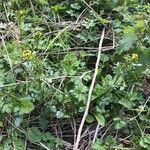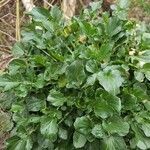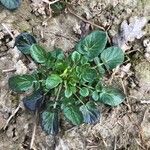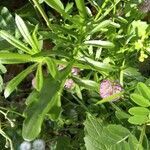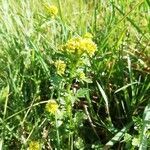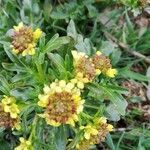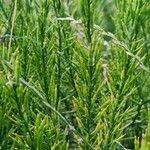Biennial (? to short-lived perennial) herb with 1-few stems from the base.. Stem robust, erect or ascending, simple or with rather few ascending rigid branches, glabrous, 10–50 cm. high.. Rosette and lower cauline leaves petioled, lyrate-pinnatipartite, up to 12 cm. long; terminal lobe reniform, orbicular or broadly elliptic, entire to sparsely dentate; lateral lobes in 1–5 pairs, sessile, lanceolate, obtuse, 5–15 mm. long; upper cauline leaves sessile, auriculate, lyrate-pinnatipartite to-pinnatifid with 1-few pairs of lateral lobes and terminal lobe reniform, elliptic or rhomboid, often comprising 1/2–3/4 of the total leaf-length; all leaves glabrous or with sparsely ciliate margins and petioles.. Racemes ebracteate, rather dense, with numerous small flowers, in fruit dense but elongate, up to 20 cm. long; pedicels in fruit stiff, ascending, 4–6 mm. long, with ascending siliquae.. Sepals green, broadly elliptic, obtuse, 2–2.5 mm. long.. Petals yellow, spathulate, with rounded apex, 3–6 mm. long.. Anthers obtuse, ± 0.5 mm. long.. Siliqua linear to narrowly oblong, 9–25(–30) mm. long, (1.2–)2–3 mm. broad (in E. Africa when fully ripe at least 2.5 mm. broad), abruptly narrowed to the style, which is ± 1 mm. long, 0.5 mm. broad; stigma not broader than style; valves with distinct midnerve.. Seeds dark brown, spheroidal or flattened and oblong in outline, 1.2–1.5 mm. long, foveolate.. Fig. 17.
Glabrous or sparsely hairy biennial. Stems branched above, (20)-30-60 cm tall. Rosette lvs lyrate-pinnate, glabrous or sparsely hairy especially on petiole and margins, (5)-8-18-(25) × (1.5)-2-3-(4) cm; terminal lobe of oldest lvs ovate to oblong with cordate base, becoming narrower and less cordate on younger lvs; lateral lobes in (0)-2-5 pairs, < width of terminal lobe; margins entire or sinuate. Stem lvs becoming deeply pinnatifid with deflexed or amplexicaul lobes at base; terminal lobe narrowly ovate, cuneate or obovate, rather irregularly toothed or lobed or entire; lateral lobes in 1-4 pairs, linear. Raceme to 35 cm long; pedicels erecto-patent at fruiting, 3-5 mm long. Sepals glabrous, 2-3.5 × 1.5 mm. Petals 4.5-5-(6) × 1-1.5 mm. Silique erect to erecto-patent, 20-30-(40) × 1.5-2 mm; style 1-1.5 mm long.
Biennial herb to 60 cm tall, erect, glabrous. Basal leaves lyrate-pinnatisect with 2–5 pairs of lateral lobes, petiolate. Sepals erect to spreading, to 3 mm long. Petals 5–6 mm long. Siliqua linear, 10–30 mm long, c. 2 mm wide; style persistent, 1–1.5 mm long; pedicels erect, stout, 3–5 mm long. Seeds broadly elliptic, c. 2 mm long.
A cabbage family herb. It is an erect herb which keeps growing from year to year. It grows about 60 cm high. The lower leaves have 5-7 lobes. The end lobe is oval. The flowers are yellow. The fruit are long, narrow pods.
